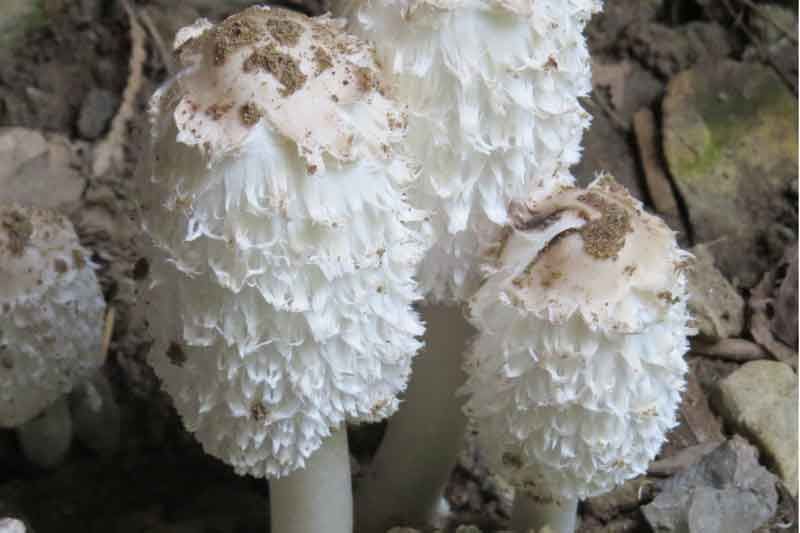Lorraine Julien | Nov 06, 2013
by Lorraine Julien
It seemed that everywhere I turned this fall, there were mushrooms all over the place. There were loads of interesting mushrooms of all shapes and sizes just under the damp leaves. On a walk through the woods recently, I discovered numerous mushrooms climbing up the sides of old stumps and fallen logs doing their part to recycle the rotting wood.
One of the most common and easy to recognize wild mushrooms I’ve encountered is the “Shaggy Mane” (Coprinus Comatus), a member of the Inky Cap family of mushrooms (so named because they all age quickly into inky-like liquids). They are edible when eaten fresh – lots of people eat them though they have no appeal for me! Another name for these mushrooms is Lawyer’s Wig – I suppose this is from long ago times when lawyers wore long white wigs in court.
Though Shaggy Manes are found mostly in hard, gravelly areas, particularly along roadsides in very late summer or fall, they may also pop up in lawns and pastures. They can be found all over the world and are obviously not fussy about the type of soil they grow in. Like most mushrooms, they pop up like magic almost overnight, especially after a rainfall.
When they are young and fresh, Shaggy Manes are quite striking and pretty. The caps are 5-15 cm across, conical to bell-shaped and covered with brown or blackish recurved scales. At first they are an off-white but age quickly, turning to gray and black. If you do gather some for the table, choose only truly prime specimens, refrigerate them as quickly as possible and serve them that night or, at the latest, the next day; otherwise they will turn to ink. In fact, one mushroom book suggests that you should melt butter in the pan before you pick the Shaggy Manes. Joking, of course, but this shows just how fast you would need to cook them.
In the accompanying picture

, I came across this cluster of Shaggy Manes inside our carport this past Thanksgiving weekend. They nearly always appear in groups but after just a day or two, they deteriorate very quickly.
As they age, strange things happen to the Shaggy Mane. Its gills and cap deliquesce, which means that they self-digest and turn into a black inky fluid as does its relative, the Inky Cap mushroom. As the spore-containing liquid drips to the ground, the species renews itself. It’s said that the black fluid can be diluted with water and used as ink.
Although this is one of the safest wild mushrooms, the Shaggy Mane may, very rarely, cause a reaction like any Inky Cap mushroom does with those who consume these mushrooms while drinking alcoholic beverages. Your ears and nose may turn red with light-headedness, a rapid heartbeat, sometimes nausea and a strange metallic taste in your mouth. As some of you may know, these are the same symptoms of Antabuse or Disulfiram, the drug sometimes given to alcoholics to make consumption of booze an unpleasant experience. In fact, Inky Caps (Coprinus Atramentarius) are used in the making of Antabuse. Fortunately for alcoholics and mushroom lovers, recovery is normally quick and complete.
One other note of caution: Shaggy Manes often grow beside heavily travelled roads. You should think before picking these mushrooms as well-travelled roads are likely to have had all kinds of stuff (oil, antifreeze, transmission fluid to name a few) leaked onto the surface. When it rains, these pollutants get washed to the shoulders where it may sink into the soil and contaminate anything growing there. There’s also the possibility that the roadside may be sprayed with herbicides.
If you still feel like eating these mushrooms, they will not poison you when eaten fresh. Once they begin to turn black, they are not very appetizing to look at. I will stick to morels, possibly fresh puffballs and the mushrooms I can buy in a store!
Please feel free to report any observations to Lorraine Julien at This email address is being protected from spambots. You need JavaScript enabled to view it. or Steve Blight at This email address is being protected from spambots. You need JavaScript enabled to view it.
More Stories
- Harrowsmith Public School and the Magic of Theatre
- You’re a Good Man Charlie Brown – a school wide effort at SHS
- Leadership From Within
- New Bulk Water Station in Sydenham
- Frontenac County Council looks at Healthcare Recruitment
- Good Turn Out Maple Fest Despite Rain
- Future looking brighter for Denbigh Fire Department says Chief
- Local Favourites featured at 2nd Annual SF Music Festival
- Perth Festival of the Maples, Saturday, April 27
- South Frontenac Council

